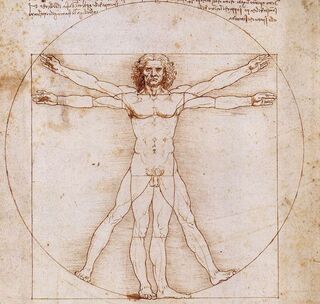Creativity
Leonardo’s Analogies and Creativity
Analogies provided Leonardo with insights for his painting and science.
Posted October 19, 2022 Reviewed by Gary Drevitch
Key points
- Analogy is a major source of creativity.
- Leonardo da Vinci used abundant analogies to guide his insights into the human body and how it could be depicted in paintings.
- Leonardo’s favorite analogy compared the macrocosm of the universe and the microcosm of the human body, but the analogy was sometimes misleading.
Leonardo da Vinci is rightfully regarded as a genius for his fabulous paintings, medical discoveries, and original technologies, all described in Walter Isaacson’s wonderful biography. Isaacson describes numerous sources of Leonardo’s immense creativity, including his relentless curiosity, sense of wonder, capacity for detailed observations, and ambitious imagination. Analogical thinking is widely recognized as a common engine of creativity, and Isaacson describes how analogies contributed to Leonardo’s paintings, architecture, and medical discoveries.
According to Isaacson, the deepest analogy for Aristotle was between the microcosm of the individual human and the macrocosm of the entire earth and universe. This analogy was common among the ancient Greeks such as Aristotle and the medieval thinkers influenced by him. The analogy is bidirectional, suggesting that we can learn about humans by reflecting on the whole cosmos, and also learn about the cosmos by reflecting on humans. Today, a fruitful bidirectional analogy is between the brain and computers, because computation suggests mechanisms for how the brain works, and neural networks suggest new ways of doing computation.
Specific applications of the microcosm/macrocosm analogy in Leonardo’s thought included the branching patterns found in the arteries of the human body, tree branches, and rivers with their tributaries. Not content with noticing superficial similarities, he analyzed the relationships of these branching systems based on the size of the main trunk, artery, or river. He deepened the analogies further by applying geometrical shapes such as triangles.
These analogies influenced Leonardo’s scientific work. His anatomical research on the human digestive system was partly inspired by a comparison between the bile that goes to the stomach and the water in rivers. A different analogy informed his discovery of atherosclerosis when he dissected a deceased 100-year-old man whose arteries he described as like a desiccated orange with tough peel and diminished pulp. He insightfully associated a fetus in the womb with a growing plant. Leonardo also compared the heart and arteries to sprouting seeds.
Leonardo also exploited the creative potential of multiple analogies by comparing the veins and arteries to other biological systems – digestive, urinary, and respiratory. He also used more long-distance analogies by comparing blood flow in arteries to the flows of rivers, movements of airs, and branching of plants. Through extensive work on machines, Leonardo was able to see analogies between various movements in the world such as between human limbs and designed mechanisms.

The microcosm/macrocosm analogy even influenced Leonardo’s paintings. Isaacson points out that the background of the majestic Mona Lisa is a landscape that shows the living body of the earth that flows into the woman and becomes a part of her. Other paintings such as the Virgin of the Rocks also display geology and water flowing into people. Leonardo’s iconic Vitruvian Man gets its name from the Roman architect Vitruvius and reflects an appreciation of geometric relations between the human body and well-designed buildings, as well as the universe as a whole.
Leonardo’s ability to draw human hair realistically drew on his perception of an analogy between hair curling and the motion of water. In his fabulous Lady with an Ermine, the animal added later by Leonardo is a metaphor for the Duke who commissioned the painting of his mistress Cecilia.
Analogies can be wonderful sources of new ideas, but every analogy has its limitations that can block further invention; for example, when generals keep on fighting the last war. Isaacson describes how Leonardo noticed the limitations of the microscosm/macrocosm analogy when he was trying to explain how water flows from rivers at the top of mountains. The analogy suggested looking for vein-like flows that carry water up to the top of the mountain, but, after many attempts to figure out how this might work, he came up with a totally different, and correct, explanation based on evaporation of surface water, cloud formation, and resulting rains. Leonardo’s thinking illustrates the ability to exploit analogies but also to transcend them when they get in the way.
In my book Balance, I assess metaphors as strong, weak, bogus, or toxic depending on whether they contribute to scientific, practical, and aesthetic goals. Leonardo’s analogies should be subject to similar assessment. In particular, the microcosm/macrocosm analogy now seems like a quaint hangover from discarded theories of divine creation. Much better analogies are now available for explaining human bodies and the universe we inhabit.
References
Hofstadter, D., & Sander, E. (2013). Surfaces and essences: Analogy as the fuel and fire of thinking. New York: Basic Books.
Holyoak, K. J., & Thagard, P. (1995). Mental leaps: Analogy in creative thought. Cambridge, MA: MIT Press.
Isaacson, W. (2017). Leonardo da Vinci. New York: Simon and Schuster.
Thagard, P. (2012). The cognitive science of science: Explanation, discovery, and conceptual change. Cambridge, MA: MIT Press.
Thagard, P. (2022). Balance: How it works and what it means. New York: Columbia University Press.


